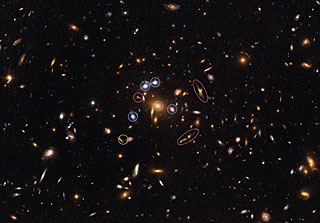
We got an honarable mention with the gravitational lens picture! [Oct 31, 2008]

Gravitational lens may result in the observation of multiple images of the same object in space.
The gravitational lens image that we submitted to the Physics Picture Contest organized by Iowa State University's Physics and Astronomy department was awarded honorary mention. The picture, titled Curvature of the Heavens, now decorates the hallway of Old Physics building at Iowa State University. Prof. Lee Anne Wilson was the one who actually made this contest possible. Keren Sharon of Tel-Aviv University, who has contributed to this great image with Eran Ofek of CalTech, was happy to know their picture was selected.
Every galaxy (or any other mass) deflects light, up to some extent, coming from a distant light source in space such as supernova explosion or another galaxy. Due to this deflection of light if the astronomers are lucky enough in terms of their position in space with respect to the deflecting galaxy, they can view two or even more number of images of the same galaxy by pointing their telescope to different directions. This is the result of so-called "gravitational lens" in astronomy [1]. It works pretty much the same way as optical lenses with electromagnetic waves instead of gravitation.
In the awarded picture (Figure 1) taken by Hubble telescope a galaxy with multiple images is shown [2]. The blue circles show a unique five times gravitationally lensed quasar. This image is the first-ever picture of such an object. The red circles mark three remarkably different images of the same background galaxy. The galaxy is 12 billion light years away (corresponding to only 1.8 billion years after the Big Bang). The yellow circle marks a supernova that was found by comparing this image to a picture of the cluster obtained with Hubble earlier.
References
[1] Bernard F. Schultz, "Gravity from the Ground Up", (Cambridge University Press, 2003).
[2] The European Homepage for the NASA/ESA Hubble Space Telescope, "http://www.spacetelescope.org/copyright.html"